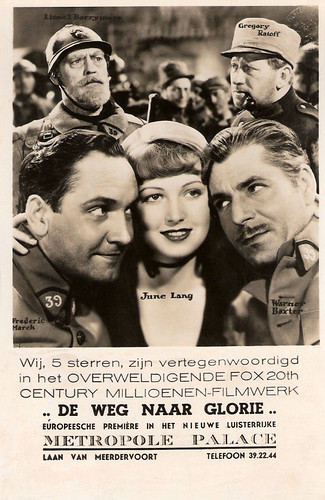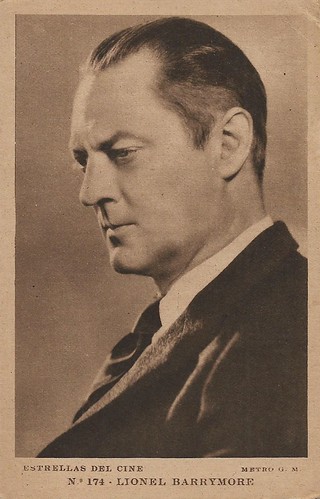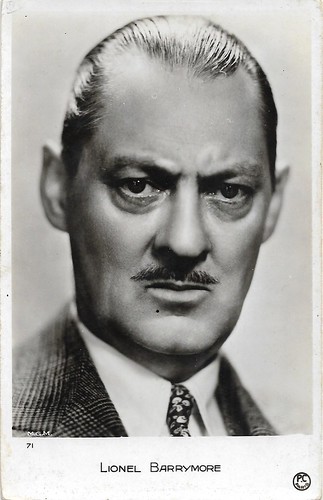
British "Real Photograph" postcard.

French postcard by A.N. (A. Noyer), Paris, no. 846. Photo: Metro-Goldwyn-Mayer.

British postcard by Valentine's, no. 5904 H. Photo: M.G.M. (Metro Goldwyn Mayer).

British Real Photograph postcard. Photo: Metro-Goldwyn-Mayer Pictures.

British postcard in the Picturegoer Series, London, no. W 733. Photo: MGM (Metro Goldwyn Mayer).
A real stage family
Lionel Barrymore was born Lionel Herbert Blythe in Philadelphia, Pennsylvania, in 1878. His family was a real stage family: his mother, Georgiana Drew, was an actress, and his grandfather was legendary theater actor John Drew.
His sister was Ethel Barrymore and his brother was John Barrymore. He first acted with his kid brother John in the 1905 play 'Pantaloon'.
Lionel was first seen on the silver screen in 1908. It wasn't until 3 years later, in 1911, that he really became a film actor at Biograph under the direction of D.W. Griffith. Barrymore made The Battle (1911), The New York Hat (1912), and Friends and Three Friends (1913). In 1915 he co-starred with Lillian Russell in a film called Wildfire, one of the legendary Russell's few film appearances. He acted in more than 60 silent films with Griffth.
In addition to acting at Biograph, Lionel also tried his hand at directing. At Metro Pictures, he helmed many pictures, including directing his sister Ethel in Life's Whirlpool (1917). In 1923, Barrymore and Irene Fenwick went to Italy to film The Eternal City (George Fitzmaurice, 1923) for Metro Pictures in Rome, combining work with their honeymoon.
He occasionally freelanced, returning to Griffith in 1924 to film America (D.W. Griffith, 1924), starring Carol Dempster. In 1924, he also went to Germany to star opposite Ivy Duke and Werner Krauss in the Anglo-German co-production Decameron Nights (Herbert Wilcox, 1924), based on the novel Decameron by Giovanni Boccaccio, and filmed at Ufa's Babelsberg studios outside of Berlin.
In 1926, Lionel joined MGM. He was their favourite and therefore worked non-stop in the most famous films. Famous silent films on his resumé are The Temptress (Fred Niblo, 1928) with Greta Garbo and Sadie Thompson (George Walsh, 1928) with Gloria Swanson.
He also proved himself as a director in the period from 1929-1931. He directed John Gilbert in His Glorious Night (1929) and guided Ruth Chatterton to consideration for an Oscar in Madame X (1929), for which he garnered his own Oscar nod as Best director.
In 1930, Lionel received an Academy Award for his role in the film A Free Soul (Clarence Brown, 1930) with Norma Shearer, Leslie Howard, and Clark Gable.

German postcard by Ross Verlag, Berlin, no. 139/3. Photo: Metro-Goldwyn-Mayer. Greta Garbo, Ramon Novarro, and Lionel Barrymore in Mata Hari (George Fitzmaurice, 1931).

Dutch postcard by JosPe, no. 361. Photo: MGM. Joan Crawford and Lionel Barrymore in Grand Hotel (Edmund Goulding, 1932).

Dutch postcard for Rembrandt Theater, Utrecht, 1933. Photo: M.G.M. (Metro-Goldwyn-Mayer). John Barrymore, Ethel Barrymore, and Lionel Barrymore in Rasputin and the Empress (Richard Boleslavsky, 1932).

British postcard by Film Weekly. Photo: MGM. Miriam Hopkins, Stuart Erwin, Franchot Tone, and Lionel Barrymore in The Stranger's Return (King Vidor, 1933).

Dutch postcard for Metropole Palace, Den Haag (The Hague). Photos: 20th Century Fox. Fredric March, June Lang, Warner Baxter, Lionel Barrymore, and Gregory Ratoff in The Road to Glory (Howard Hawks, 1936). Caption: We, 5 stars, are represented in the overwhelming Fox 20th Century millions-film work The Way to Glory. European premiere in the new glorious Metropole Palace, Laan van Meerdervoort, telephone 39.22.44.
The third main actor of the cast
Lionel Barrymore was most famous in the 1930s, 1940s, and 1950s. Barrymore appeared in Mata Hari (George Fitzmaurice, 1931) with Greta Garbo and Ramon Novarro.
With Garbo, he also appeared in Grand Hotel (Edmund Goulding, 1932) with an all-star cast including Joan Crawford, Wallace Beery, and Lionel's brother John Barrymore. Lionel reunited with his brother John in another classic, Dinner at Eight (George Cukor, 1933), again with an all-star cast including Wallace Beery, Marie Dressler, and Jean Harlow.
His other films of that decade include Treasure Island (Victor Fleming 1934) again with Beery, Camille (George Cukor, 1936) with Garbo, Saratoga (Jack Conway, 1937) with Clark Gable and Jean Harlow, and Captains Courageous (Victor Fleming, 1937) with Spencer Tracy.
For director Frank Capra, he acted in You Can't Take It with You (Frank Capra, 1938) with James Stewart and Jean Arthur, and the popular Christmas film It's a Wonderful Life (Frank Capra, 1946) again with Stewart. He was well-known for playing Doctor Gillespie in the Doctor Kildare films of the 1930s and 1940s.
Often, Barrymore was the third main actor of the cast. Among his last films were Duel in the Sun (King Vidor, 1946), Key Largo (John Huston, 1948), Down to the Sea in Ships (Henry Hathaway, 1949), and Right Cross (John Sturges, 1950).
By then, Barrymore was disabled, having broken his hip twice, with his deteriorating condition exacerbated by arthritis. He played his later roles in a wheelchair. His final film was the musical comedy Main Street to Broadway (Tay Garnett, 1953), in which he appeared with his sister Ethel.
He worked as an actor until his death in Van Nuys, California, in 1954. Lionel Barrymore's family remained a real theatre and film family: he was the uncle of John Drew Barrymore and the great uncle of Drew Barrymore.

Spanish collector's card by La Novela Semanal Cinematografica, no. 138.

Spanish postcard in the Estrellas del cine series by Editorial Grafica, Barcelona, no. 174. Photo: Metro-Goldwyn-Mayer.

French postcard by P.C., Paris, no. 71. Photo: MGM.

British Real Photograph postcard in the Picturegoer Series, London, no. 632.

Belgian Collectors Card by Kwatta, Bois-d'Haine, no. C. 133. Photo: M.G.M. (Metro-Goldwyn-Mayer). Serie C. 99-196.
Sources: Jon C. Hopwood (IMDb), Wikipedia, and IMDb.
No comments:
Post a Comment